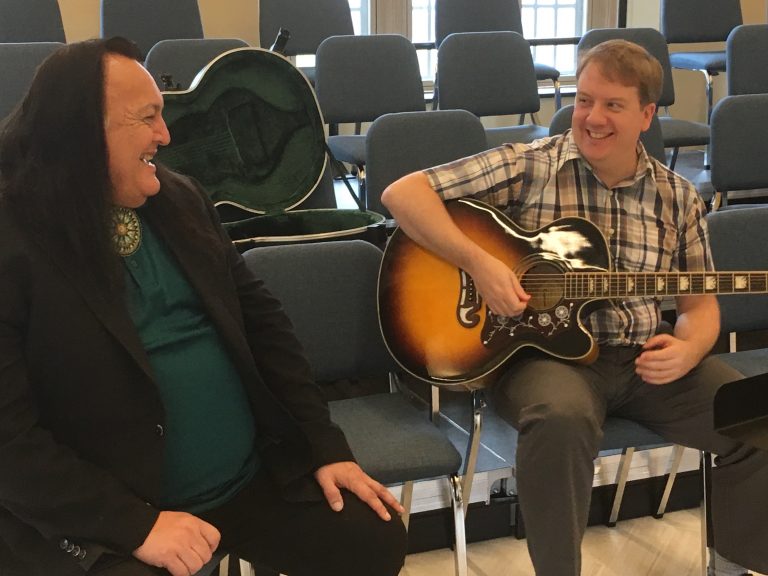SINGING "JESU PASCHGON KIA": INTRODUCTION TO THE RECORDING PROCESS
By tracing the textual history of the written hymns through a wide variety of Moravian sources—mission diaries, synod records, collections of hymn manuscripts—we have gained deeper insight into the web of relationships that facilitated the creation and singing of the Mohican hymns in the eighteenth century. Re-sounding these hymns in the present is likewise rooted in an extensive web of relationships among scholars, musicians, and community members, each of whom was drawn to Box 331 for quite different reasons. Individually, as historians, musicologists, linguists, and descendant community members, we were limited in our ability to “hear” the voices in Box 331. But together we each possessed pieces of knowledge that would make it possible to sing “Jesu paschgon kia” in three different versions. Each of our three renderings of the hymn sounds markedly different from the others, an aural reminder of the multiplicity of meanings that are generated through encounters with historical sources.
Following the many pathways of “Jesu paschgon kia” illuminates the nature of relationships between the missionaries and Native affiliates of the Moravians while also making us acutely aware of the biases of the sources. Moravian missionaries wrote far more about Native peoples than did their Anglo-Protestant counterparts, yet volume alone cannot make up for the paucity of Native voices. This absence became all the more palpable as we attempted to reconstruct the hymn as it might have sounded in the eighteenth century. It quickly became clear there was a wealth of information about contemporary European Moravian musical practices, but virtually nothing about Mohican music and only a scant few references to how Mohican singers sounded, leaving us to wonder whether Native singers chose to adopt Moravian musical aesthetics and to what degree Native musical traditions influenced the Mohican practice of hymnody. That the Moravian musical style marked a substantial departure from the Mohicans’ familiar musical ways is suggested by the comment of one Pachgatgoch resident, Martin, who expressed his frustration with learning to sing and his expectation that in heaven singing would be easier.53
Our desire to hear the hymns of Box 331 sent us down additional paths of inquiry that we otherwise would not have pursued. We needed to find the chorale tunes cited on the hymn manuscripts and reunite them with the texts, which required Sarah’s deep knowledge of Moravian musical practices and archives. Then, working with linguist Chris Harvey, we were able to undertake our first historically informed recording, produced by the early music choir Cantores Musicae Antiquae (Singers of Ancient Music) under Sarah’s instruction and direction at FSU. This recording reflects our best understanding of how the hymns would have sounded if we assume adherence to the ideals of eighteenth-century European Moravian worship music. It does not, however, reflect what influences there may have been from Mohican members of the community that went unrecorded in the written record.
Building cautiously from what we know of northeastern Native musical practices and contextual evidence from the mission records, we maintain that the Mohican Moravians participated in hymnody in ways that carried on the function of Indigenous ceremonial music: forging and reinforcing communal ties among and between members of the community and their neighbors.54 Our second recording thus privileges the parallel interests of today’s Church of the Wilderness congregation on the Stockbridge Mohican Reservation in Wisconsin in learning to sing hymns in Mohican to deepen their connection with Mohican language and history. This recording is based upon a reharmonized version of the original chorale tune by Brent Michael Davids (Mohican), a composer living on the reservation.55 Finally, the third recording speaks to the vast silences of the Moravian mission records: diarists noted that Mohican men often sang hymns while out on hunting expeditions (and also noted the success of the hunts!). Though we cannot know just how those hunters might have sounded as they sang the Mohican hymns, our third recording privileges a roughly parallel interest: a contemporary Stockbridge Mohican (and Christian) musician, Bill Miller, who sees his music as reflective of individual spiritual experiences, the sounding of which is done in service of his community, broadly conceived.56 In this recording, he sets the words of “Jesu paschgon kia” to new music that reflects his adaptations of traditional Native musical forms.
The stark differences in these three recordings represent, in a sort of aural shorthand, varied ways of thinking about the significance of a single eighteenth-century text. Hearing this hymn in three modes has helped us to appreciate more fully the silences that loom over the voluminous Moravian records. Below, we detail the work behind each recording of “Jesu paschgon kia,” the collaborations that emerged from our attempt to hear this and other Mohican hymns from Box 331, and the role those collaborative scholarly meanderings played in increasing our understanding both of their eighteenth-century context and of the diverse and often divergent meanings and uses of those hymns for each of us today.











